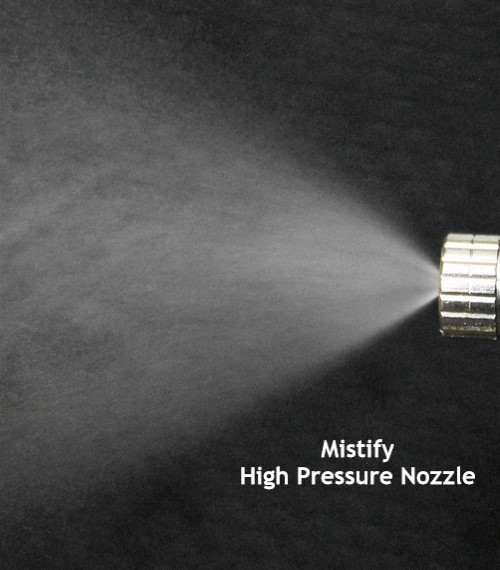High vs Low Pressure Misting
High Pressure versus Low pressure misting
Definitions:
Low pressure misting normally refers to systems that run at less than 100 psi (7 BAR or 700kpa). They are connected directly to your garden tap which is 3-5 bar pressure (on average). The tube to attach the nozzles is polyethylene or nylon the fittings are normally plastic, and the nozzles are brass and stainless steel. The mist droplet size that is produced is around 50-70 microns (approximatel the width of a human hair) and, from a height of 2 metres, will take approximately 14 seconds to hit the ground.
High pressure systems from Mistify are 1000psi (70bar, 7mpa) and require a specialised pump. The tube between nozzles is stainless steel, the fittings are nickel coated brass and the nozzles are either nickel plated brass or stainless steel. A quality stainless steel mesh filter is used as a pre filter and every nozzle is equipped with its own micro filter as well as anti-drip device and impeller to produce ultra-fine mist. The mist droplet size that is produced is around 4 microns and, from a height of 2 metres, will take approximately 22 minutes to hit the ground (if it has not already evaporated in the mean time!)
Low pressure systems have very simple nozzles without filters and impellers and they have inexpensive plastic pre-filters.


Cost comparison:
A low-pressure system cost around $100-$200 for a twenty-nozzle system. A Mistify high pressure misting system with 20 nozzles and stainless steel tube connecting the nozzles cost approximately $1800.
Is the difference in cost worth it? You be the judge based on the following information.
The object of all misting systems is to create the smallest water droplet size possible because this creates the greatest cooling without wetting. What happens to these droplets after they leave the nozzle is critical to how a high pressure misting system works
The smaller the droplet size the larger the surface area per litre of water, the faster the “flash evaporation” and the greater the resultant cooling.
Refer: “How Misting Works” for a full explanation. Mistify uses a patented nozzle that ejects 30mls/minute whereas the industry standard is 50ml/minute or 66% more (for high pressure systems). The droplet size of Mistify mist is 3-7um (microns or thousandths of a millimetre) the droplet size of most other high pressure systems is 10-15um. Low pressure systems normally eject about 50mls/minute but droplet size are normally 30-50um.
A Truism: The smaller the droplet the better the cooling and the less wetting of surrounding area.
Why is droplet size so important?
The misting system works by ‘sucking’ heat from surrounding air in order to change state from a liquid to a vapour, thus cooling the surrounding air. If you empty a 10 litre bucket of water from 2 metres above the ground, basically it will all hit the ground and wet everything around but none evaporates. If that water was atomised to 3-7um, it will takeover 5.5 hours and each droplet would take up to 22 minutes for the droplets to find their way to the ground, the vast majority will never make it because they evaporate on the way. Those that make it evaporate on contact because they are so small. By comparison a 50um droplet (low pressure) will reach the ground in around 14 seconds. If the droplet size is ten times bigger, some will hit the ground some will evaporate. A low pressure misting system droplet is 10 times larger than Mistify systems mist – draw your own conclusions.
Air exchange and Drift
If the mist was completely static (no breeze), once the droplet evaporates the vaporised water would remain in situ not permitting any further vaporisation to occur, because humidity will reach 100%. If air exchange occurs, the cooler air containing vaporised water is blown away, then space is created for further droplets to evaporate. This energy exchange results in the consumption of heat energy which is effectively removed from the air. We do not cool the air—we remove heat from the air. Same bottom line effect as air conditioning—different methodology. This is why a fan works when you stand in front of it on a hot day. Similarly you need air movement or exchange for a misting system to work effectively. This is the case for adding fan units incorporated with misting systems, especially in enclosed environments such as horse stables, closed in veranda's or porticos. Droplet movement due to air movement (air exchange) is known as drift. The smaller the droplet size the greater the ability for the slightest breeze to exchange the air/mist.
It takes a 5um droplet 100 times longer to descend 1 metre than a 50um droplet. This is one of the reasons Low pressure wets surrounding areas and High pressure remains dry.

In order to prevent wetting and keep humidity levels down, Mistify systems incorporate recycle timers. A Misting pump runs for say 30 seconds and then turns off for 10 seconds then starts up again (user defined cycle). If you want recycling in a low pressure system, your recycle timer may cost as much (or more) than the original system, but still will not change the droplet size.
The water throughput of low pressure systems is about 50mls/min @ 3-5bar. Compare this to Mistify’s 30mil/min @ 70bar. The question is “If the quantity of water ejected by a low pressure system is 66% greater than Mistify’s system, why is it not cooler?” The answer is in the droplet size and the surface area of the water ejected. 30 mils of water split into an average droplet size of 5um has a significantly larger surface area than 50 mils of water with an average size of 40um.
Will Mistify systems cause wetting?
The simple answer is NO!
Correctly installed and operated our misting system will not cause wetting.
Correctly installed means:
· The right number of nozzles are fitted.
· The correct size nozzles are fitted.
· Nozzles are spaced appropriately.
· Adequate air exchange is available.
· Correctly operated means the system is equipped with a duty cycle timer to match the conditions of the day. Cooler/High humidity days require shorter time cycles.
The proof is seen wherever you see commercial misting systems. If low pressure was as efficient as high pressure systems, no one would spend the extra money.
Who uses misting systems:
Sporting events, Hotels/Clubs, Horse stables, Restaurants/Bars, Poultry Sheds, Plant nurseries
Why is Misting being used in Industry but not residentially?
We are not certain, industries such as poultry raising have known about mist cooling for years, and nearly every poultry raiser uses it. Is it perceived cost. Mistify’s average misting system for an outdoor veranda or deck costs less than a small split system air-conditioner. Ring us and find out if its right for you.


